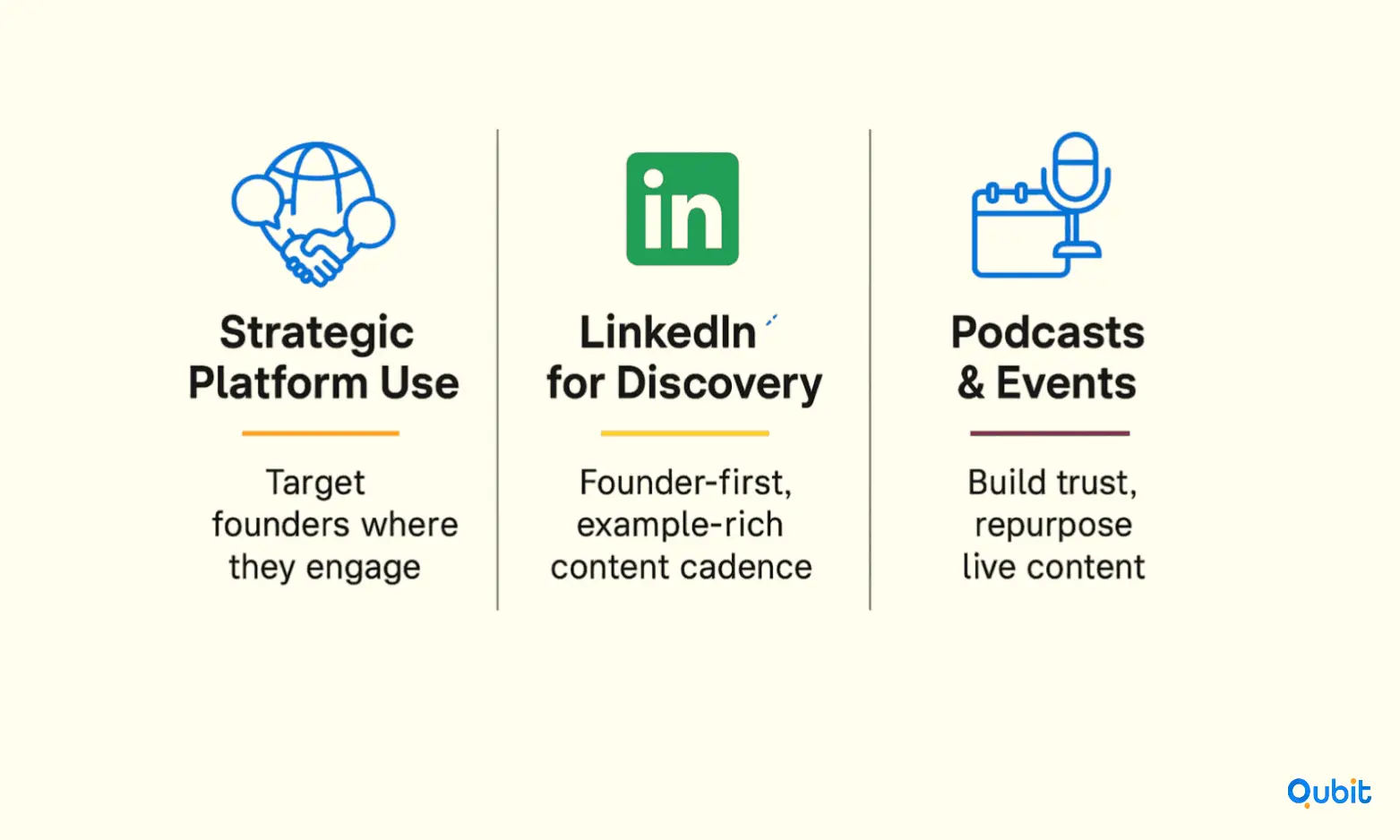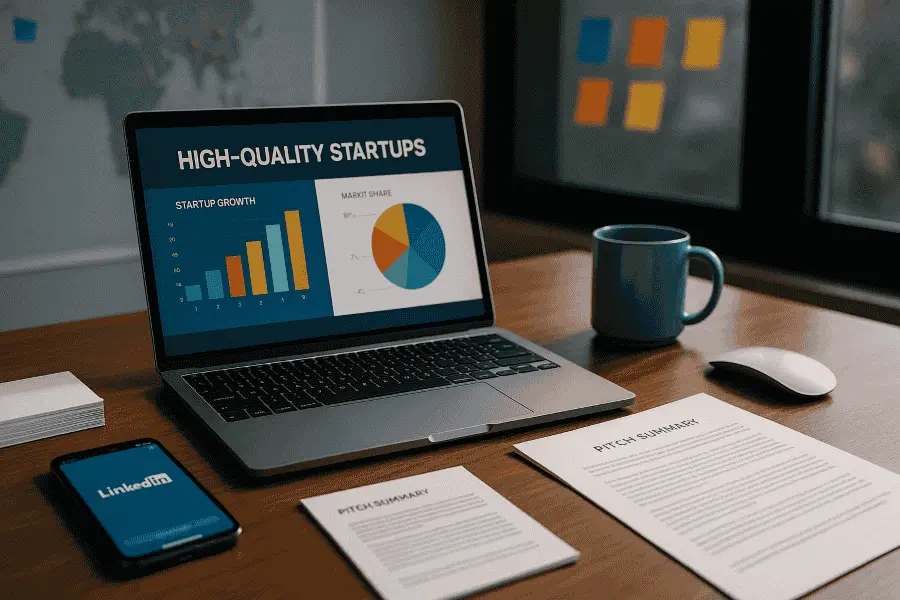Investors that consistently win competitive allocations don’t rely on chance, they operate an integrated outreach engine across multiple channels, guided by a clear thesis, strong content, on-platform engagement, and community presence. Done well, this doesn’t just improve deal discovery; it compounds into inbound from founders who are already qualified by stage, sector, and geography.
This article breaks down the highest-yield startup outreach channels for investors, how to structure campaigns, the role of marketing in investor brand building, and what to measure, without falling into scattershot tactics or vanity metrics.
Let's get started!
Defining Your Thesis Before Channel Selection
Outreach efficiency rises dramatically when the thesis is explicit. Investors should articulate stage sweet spot, sector themes, geo boundaries, check sizes, follow-on posture, and the specific post-investment edge offered. This clarity informs content topics, determines where to show up, and filters inbound. For example, a firm backing vertical AI copilots for enterprise workflows will choose different channels, events, and content formats than one backing frontier climate hardware.
A public, concise thesis page also shortens cold-email cycles and gives founders a quick read on fit. When elaborating the system-level playbook, it helps to guide readers to a structured overview like startup outreach guide, which aligns messaging, channels, and measurement into a practical operating plan.
Mapping the Founder Journey for Targeted Outreach
Effective outreach starts with understanding where target founders spend time and what they need at each stage. Technical founders deep in build mode frequent open-source repositories, research communities, and product forums; go-to-market oriented founders engage in niche Slack groups, operator newsletters, and procurement meetups; deep tech and regulated-industry teams orbit university labs, standards bodies, and domain conferences.
By mapping these journeys, discovery, validation, first customers, compliance, and scale, investors choose channels that meet founders where they work rather than broadcasting broadly to other investors.
This is also where channel selection pairs with editorial strategy: content that resolves a friction point at a precise stage will outperform generic “we invest in X” statements across every platform.
Owned Media Foundations for Long-Term Deal Flow
Owned media is the most durable, compounding asset in an investor’s outreach stack. A focused blog that publishes operator-grade playbooks, teardown analyses, and decision tools becomes the nexus for search discovery, social distribution, and email nurturing.
Editorial discipline matters: solve concrete problems with specificity, share frameworks founders can reuse, and back claims with examples or benchmarks. This approach not only compounds in search but also powers internal linking that guides readers naturally to related resources.
When the topic shifts to persona-led discovery on social platforms, direct them to investors find startups on LinkedIn for a deeper exploration of cadence, formats, and DM etiquette.
Building a High-Value Investor Blog
An investor blog should function as a living knowledge base for a chosen thesis. Start with a hub-and-spoke architecture: publish a hub article that explains the “why now,” outlines buyer economics, and defines what early traction looks like; then build spokes that address granular issues such as pricing experiments, onboarding friction, security compliance, and pilot-to-paid conversions.
Each spoke should include a single, clear call-to-action, apply for office hours, submit a founder brief, or access a template library. Over time, this structure establishes topical authority and improves organic discoverability for high-intent queries like “startup outreach channels for investors,” while giving founders a coherent path from reading to engagement. To reinforce this system with a repeatable framework, pointing to content marketing for investors helps translate editorial strategy into a campaign calendar and repurposing plan.
Newsletters That Convert Readers into Relationships
Newsletters convert anonymous readers into a known audience with ongoing dialogue. The best-performing formats alternate between deep, actionable guides and timely perspectives on market shifts that affect founder decisions. Segmenting subscribers by thesis fit and stage allows for targeted calls-to-action, from thematic office hours to curated founder circles.
A monthly rhythm keeps signal high without overwhelming inboxes, especially if issues follow a consistent template: a core insight, a practical tool or framework, a short case vignette, and a specific ask. When a newsletter references channel orchestration, it can point readers to a deeper post via internal linking, something like
Using Social Platforms for Startup Discovery
Social channels turn owned content into distribution and create context for relationship-building. LinkedIn is the highest-leverage platform for professional discovery in B2B and enterprise ecosystems, while X is better for real-time discourse and technical communities.
The goal is to participate where target founders converse and to contribute with unique, operator-grade insight that stands out from generic investor commentary. Short, example-rich posts, teardown threads, and diagrams have outsized impact, especially when followed by prompt, thoughtful engagement in the comments.

Using LinkedIn as a Primary Professional Discovery Tool
On LinkedIn, founders follow people before they follow firms, so partner accounts should carry the editorial weight. A consistent cadence, three to five posts per week, can revolve around patterns observed in customer conversations, real-world procurement obstacles, and data-backed insights from portfolio experiments. Posts that teach one specific concept with a clear example outperform high-level trend commentary.
Direct messages should reference a concrete, recent founder action and offer specific help rather than pitching a meeting immediately. This approach earns permission for a future conversation and strengthens the investor’s reputation in the founder community.
Extending Reach with Podcasts, Webinars, and Virtual Events
Long-form audio and live sessions build trust at scale by letting founders hear how investors think through real problems. Podcasts can rotate formats between founder interviews, operator clinics, and sector maps, while webinars and AMAs tackle narrowly defined topics where attendees leave with templates or checklists.
These assets also create a library of clips and transcripts for social. Crucially, live events should lead to a next step that fits the participant’s situation, such as an invite to thematic office hours or a short founder brief submission. The mechanics, from planning topics to repurposing content, are outlined in investor outreach podcasts, ensuring each event supports the broader campaign goals rather than operating as isolated media.
Partnerships with Accelerators, Universities, and Ecosystem Programs
Partnerships accelerate access and bolster trust because they rely on curated, mission-aligned communities. Relationships with accelerator partners, incubators, and university labs open doors to founders earlier in their journey and allow investors to contribute meaningfully through workshops, mentorship, and pre–demo day office hours. These are not mass-market channels; they’re relationship engines where credibility compounds with each session delivered and each founder helped.
For investors focused on deep tech, medtech, or climate, a standing presence with tech transfer offices and research centers can become a primary sourcing lane. In parallel, investor-led reverse pitch events, where the investor articulates thesis, check size, and value-add to founders, clarify fit, reduce noise, and build goodwill in the ecosystem.
Structuring Reverse Pitches and Office Hours for Conversion
Reverse pitches should begin with specificity: who the investor funds, the metrics that merit a call, what help is provided post-investment, and how decisions are made. End with a single application path and a transparent follow-up timeline to prevent drop-off.
Themed virtual office hours convert attention into focused conversations when they are well-scoped (“SOC 2 readiness for healthcare integrations” rather than “security”), require a concise one-page founder brief, and deliver a useful follow-up whether or not a deal proceeds.
This programmatic approach turns episodic outreach into a continuous pipeline, reinforces brand trust, and surfaces non-obvious founders who are building in the targeted niche. For an execution blueprint that turns these concepts into repeatable motions, see reverse pitch events, and for the broader orchestration.
Media, PR, and Thought Leadership: Building Pull, Not Just Reach
PR works when it delivers founder utility, not just investor vanity. The most effective media efforts package original insight into decision tools founders can act on immediately: benchmark studies for pricing in a specific vertical, teardown analyses of enterprise procurement cycles, or postmortems that show exactly how a pilot moved to paid. Instead of chasing broad headlines, prioritize trade publications and domain newsletters where thesis-fit founders already spend attention.
Time PR to coincide with thematic campaigns so each article or interview points to owned assets and a clear next step, like signing up for themed office hours or submitting a one-page founder brief.
Thought leadership is more than opinions, it’s a repeatable practice of publishing frameworks, data, and examples that hold up under scrutiny. One effective cadence is to release a flagship thesis piece, follow with two deep-dive playbooks, and then host a live session to stress-test the ideas with operators and founders. This creates a structured dialogue loop: publish, discuss, refine, and implement. To convert attention into relationships, each media moment should route to a specific destination on owned channels.
For example, a sector pricing analysis in a niche outlet can direct readers to a hands-on toolkit hosted on your blog, which then invites founders to a small-group clinic. The PR-to-owned pipeline approach mirrors the system laid out in investor PR strategies.
Each media asset should have one job, awareness, engagement, or conversion—and a single call-to-action to avoid diffusion. Over time, a consistent rhythm establishes a recognizable signal that founders anticipate.
Use selectively for operational clarity:
- Anchor each PR pitch in a founder decision: “Should we price per user or per workflow?” “How do we pass security review in 30 days?” “When does a pilot qualify as product-market fit?”
- Package evidence: anonymized cohort metrics, pipeline conversion snapshots, or case vignettes from portfolio and non-portfolio founders.
- Tie timing to campaigns, not one-off wins; route readers to a clear next step in owned channels.
- Measure not impressions but pipeline effects: office-hour signups, qualified form submissions, and meetings explicitly referencing the media asset.
Measurement That Matters: From Attention to Allocation
Outreach without measurement is theater. The goal is to understand which channels and narratives reliably convert into qualified conversations and competitive allocations. Because fundraising cycles are long and outcomes lag, prioritize leading indicators that correlate with pipeline quality and then validate them against downstream results. A clean measurement stack avoids vanity metrics and focuses on actions founders take that show intent.
Start with a minimal analytics core that ties owned channels, social, and events to CRM stages. Track the explicit journey: which post a founder read, what form they completed, which event they attended, what follow-up they received, and where the conversation progressed or stalled. Use UTMs and structured form fields to keep attribution clean, but preserve a free-text field where founders can self-report why they reached out; those qualitative signals frequently reveal unanticipated content-market fit.
Within a 90-day cycle, pay attention to:
- Owned media: qualified form starts, office-hour bookings, and replies to newsletters that ask pointed, context-rich questions. These correlate better with fit than raw pageviews.
- Social: saves/bookmarks, founder DMs that reference a specific framework, and comments that challenge assumptions and invite deeper debate. Impressions and likes are soft signals at best.
- Events: registration-to-attendance rate, attendance-to-meeting conversion, and meeting-to-diligence movement within 30 days. Optimize topics and formats that shorten time-to-substance.
- Partnerships: percentage of curated intros that proceed to a call, and the hit rate of pre–demo day engagements that move into diligence compared with public demo day interactions.
Translate signals into action by reviewing performance weekly and deciding whether to double down, pivot, or sunset a channel or narrative. A weekly 30-minute pipeline review should spotlight top-of-funnel quality, not just volume. If a post drove significant interest but low fit, revise the framing or publish a clarifying note that tightens who should engage. If an event over-indexed in quality leads, repeat the topic with fresh case material and an even clearer application path.
Editorial Standards, Governance, and Ethics
Great outreach respects founder time, privacy, and attention. Set an editorial bar that prioritizes clarity over jargon and examples over abstractions, and hold each asset to three questions: who is this for, what job does it do this week, and what is the next action? Create a short style guide that defines tone, structure, and link discipline so posts are consistent even across different authors. When referencing case material from office hours or community events, secure explicit consent and remove identifying details unless the founder agrees to attribution. Avoid pay-to-play dynamics and make disclosures around portfolio features and conflicts standard practice.
Governance ensures consistency without stifling creativity. Assign clear ownership: a partner for social/editorial, a partner for partnerships/events, and an associate for CRM and analytics. Run a weekly standup to review channel KPIs, decide on tactical changes, and commit to a tight set of deliverables. Keep a living operating charter that covers response SLAs to founder submissions, conflict escalation paths, and decision rights for campaign pivots. This clarity prevents internal bottlenecks and keeps promises to founders.
Compliance is a quiet moat. Ensure GDPR/CCPA compliance across data capture and email marketing with explicit opt-ins, easy opt-outs, and sensible data retention policies. Make it simple for founders to understand what will happen with their information, who will see it, and how long it’s stored. Trust built in small, consistent ways becomes a brand advantage over time.
Conclusion
Building a high-quality, thesis-aligned startup deal flow is not about chasing every opportunity, it’s about intentional positioning, multi-channel orchestration, and founder-first value delivery. By combining owned media, social distribution, ecosystem partnerships, live engagement formats, and data-driven measurement, investors can attract the right founders before they are on everyone else’s radar.
Consistency, specificity, and respect for founder time turn outreach from a sporadic activity into a compounding brand moat. When each touchpoint, from a LinkedIn post to a reverse pitch event, is backed by a clear thesis and a tangible next step, investor visibility translates directly into competitive allocations and long-term relationships.
At Qubit Capital, we specialize in aligning startups with the right investors through tailored services like Startup Matchmaking. If you're ready to elevate your portfolio management and connect with optimal investors, we invite you to explore how our expertise can support your goals.
Key Takeaways
- A precise thesis attracts better-fit founders and informs outreach strategy.
- Publish founder-first resources to build long-term inbound deal flow.
- Use platforms like LinkedIn to convert visibility into structured conversations.
- Collaborations with accelerators, universities, and niche communities give earlier access.
- Podcasts, webinars, office hours, and reverse pitches move beyond generic networking.
- Focus on leading indicators tied to qualified, on-thesis meetings.
Frequently asked Questions
What’s the single most effective startup outreach channel for investors?
There’s no universal “best channel”; it depends on your thesis and where target founders congregate. For B2B SaaS, LinkedIn combined with a rich content hub often works best, while deep tech may require university and lab partnerships.






